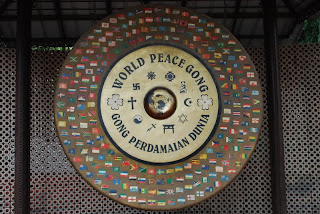My friend, Naomi, and I finally made it to Gandhi Smriti on an oddly cool and rainy day last week. I'm so glad we went. It is an amazing place and I recommend all who come to Delhi to visit. Here is some history of the place, taken directly from the site: http://gandhismriti.gov.in/indexb.asp:
Gandhi Smriti, housed in the Old Birla House on 5, Tees January Marg, New Delhi, is the sacred place where Mahatma Gandhi's epic Life ended on 30 January 1948. Mahatma Gandhi had lived in this house from 9 September 1947 to 30 January 1948. Thus, the hallowed house treasures many memories of the last 144 days of his life. The Old Birla House was acquired by the Government of India in 1971 and was converted into a National Memorial of the Father of the Nation and was opened to the public on August 15, 1973.
The preserves include the room where Mahatma Gandhi lived and the prayer ground where he held a mass congregation every evening. It was here where assassin’s bullets felled Gandhiji. The building and the landscape have been preserved as they were in those days.
The Memorial consists of: (a) Visual Aspects to perpetuate the memory of Mahatma Gandhi and the noble ideals he represented, (b) Educative Aspects to focus concentrated attention on certain values of life that made Gandhi a Mahatma, and (c) Service Aspects to introduce activities in order to subserve certain felt needs.
On display in the Museum are photographs, sculptures, paintings, frescos, inscriptions on rocks and relics pertaining to the years Mahatma Gandhi spent here. The meagre personal effects of Gandhiji too are carefully preserved.
A larger than life statue of Mahatma Gandhi, with a boy and a girl holding a dove in their hands standing on either side, emerging out of the globe, symbolising his universal concern for the poor and the deprived, welcomes the visitor at the main entrance of the Gandhi Smriti. It is the work of the renowned sculptor Sri Ram Sutar. The legend at the base of the sculpture says, "My Life is My Message".
A Martyr's Column stands at the spot where the Father of the Nation was assassinated, commemorating the Martyrdom of Mahatma Gandhi as the embodiment of all the sufferings and sacrifices that characterised the long struggle for India's Freedom.The above quote is an excellent description of what you'll see when you visit. But, make sure you go upstairs where the exhibits are interactive via touch with lights and sounds...a really great experience and wonderful way to commemorate such an important human being.
Some (a lot of) photos from our visit:
The front entrance:
Upstairs, so many very cool interactive exhibits. This one you touch and and the wall displays information about Gandhi's work.
Slide the screen and you follow the timeline of Gandhi's life:
Touch the hands and the lights appear:
Gandhi's instrument:
Photo op with statues of Gandhi and his wife:
The screen inside this train traces the path he took throughout India:
Not sure what this one was for, but very cool:
Open the boxes to see the tiny screens:
Huge kaleidoscope depicting scenes from his life:
School kids taking a tour:
Follow the cement footprints to the backside of the building where Gandhi stood for the last time:
































